Restoration of Kamov Ka-26, D-HOAY/ DDR-SPY/ DM-SPY
Ka-26 History |
||
 |
Photographed in March 2002, with restoration at an advanced stage (left), the Kamov Ka-26, D-HOAY/ DDR-SPY/ DM-SPY was built in Russia in 1970. It was used in East Germany, by Interflug, as a light transport as well as for agricultural duties. The Ka-26 was designed to carry interchangeable pods for freight, passengers, chemical spray-bars or a dust-spreader. Alternatively a hook was available for crane work and slung loads. In addition to the detachable sections carried to the rear of
the cockpit, features of the Ka-26 include two contra-rotating
co-axial 3-blade glassfibre rotors, two podded radial engines
on high-set stub wings, and twin tail booms carrying tailplane,
fins and rudders. |
|
| There was large scale use of composite materials, aluminium panels sandwiched in glassfibre, in the machine's construction. About 850 Ka-26 were built. It was the most successful Soviet helicopter to be exported commercially and was bought by at least 15 countries. Kamov continues as the only company producing helicopters, in
quantity, with twin coaxial rotors. In May 2004, they announced
that production of thirty of their Ka-226 helicopters had begun.
Four of these, from an order for 22, entered service with Gazprom,
in 2006, and are employed on pipeline patrol and maintenance duties. Two
have been delivered to the Security Services, for border patrol,
and a further two have been supplied to the Moscow police. |
||
Kamov Ka-26, DDR-SPY, Restoration |
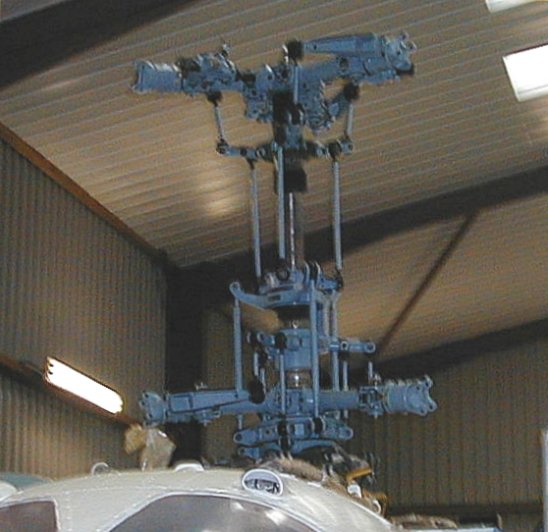 |
| DDR-SPY's mast and coaxial rotorheads were cleaned and refurbished before being painted in their original colour. |
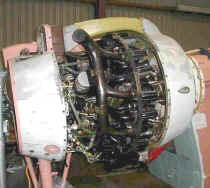 |
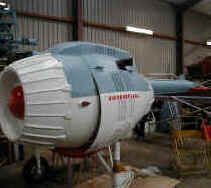 |
|
|
Above left: Starboard engine in September 2001
following restoration and renovation. The two Vedeneyev 325hp
M-14V-26 nine-cylinder radial piston engines were derivatives
of the M-14P fixed-wing series. M-14P and 14PF engines are still
in use in large numbers around the world, many powering Sukhoi
SU-26, Yak-52 and other Russian light sports aircraft famous for
their aerobatic capabilities. The M-14P, built by Aerostar in
Romania, is now probably the only radial aircraft engine in production
anywhere in the world. Above right: By 24th April 2002 the cowlings had been replaced on the engines, been painted and had the "Interflug" lettering applied. The original lettering must have been removed following German re-unification but traces were still visible when old coats of paint were stripped. |
||
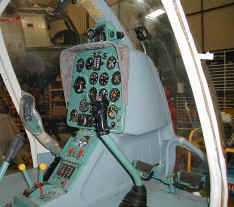 |
 |
|
Above
left: Kamov Ka-26 cockpit controls and instruments
in May 2002, following restoration. Above right: Kamov Ka-26 cockpit overhead switch panel on 27th April 2002. |
||
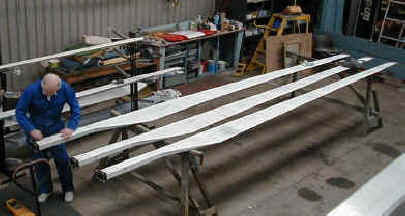 |
November 2002 and
six rotor blades are being cleaned up and painted in preparation
for installation. |
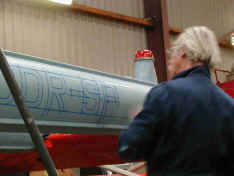 |
In early June 2002 Roger
painted the Ka-26's DDR-SPY registration on the tail booms having
made his own paper stencils from masking tape. |
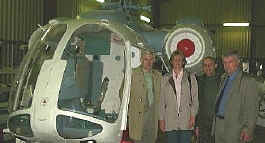 |
Veniamin Kasyanikov (left
in group), Deputy General Designer of the Kamov company in
Russia, was photographed beside The Museum's Kamov Ka-26. One
of a party visiting The Museum on 19th September 2002, from
the European Rotorcraft Forum meeting in Bristol, he offered to
try to locate a passenger pod to complete the restoration. |
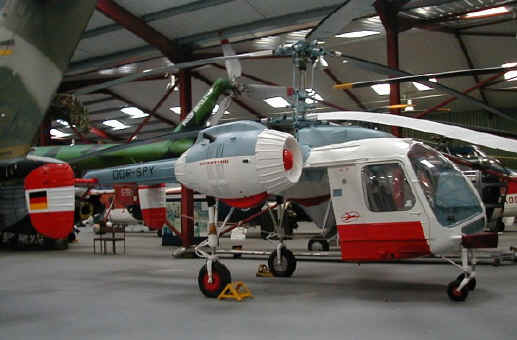 |
On 28th September 2002 the Ka-26, DDR-SPY, was moved from the Hafner (Restoration) Hangar into the main Exhibition Hangar. To make this possible the tail plane and booms were removed temporarily. Rotor blade installation finally took place three weeks later (see below), and the rudders were fitted on 27th November. In December 2002 some of the lights and cockpit electrics were activated. The Ka-26 is now in its planned permanent position, close to four other Russian machines in the Collection. The tail of the Mi-24D 'Hind' is just visible to the left(above,) with the Mi-4 'Hound' in the background. In February 2004 a passenger cabin 'pod' arrived from Hungary and, following restoration, is now displayed adjacent to DDR-SPY. |
Flying a Kamov Ka-26We are always interested to hear from website visitors who have experience of the helicopters which are being restored at The Museum. In June 2005 we heard from a pilot with Ka-26 experience. |
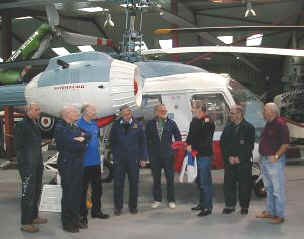 |
||
| The Ka-26 restoration was officially unveiled, on 18th December 2002, by Elfan ap Rees, founder of The Museum and Chairman of the Museum Trustees. He congratulated the restoration team of retired aircraft engineers, Gerry Bartlett (team leader), Roger Bayliss, Ben Brooks, Dennis Knowles, Derek Palmer, Keith Ringer and Alan Taylor, on a superb job. | ||
 |
||
| Installation of Kamov Ka-26 rotor blades in the Display Hangar, on Wednesday 13th November 2002, following mast positioning in late February 2002 and refurbishment of the six blades. | ||
|
